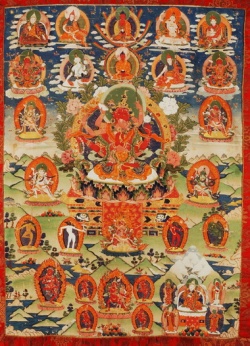The technics of Thangka paintings
The shape of Thangka is more of long vertically hung scroll of various sizes. With calico as its major material, Thangka is made through series of processes:
at first, finish the major section which include strentching the frame, gelatinizing, polishing, colluding in the line and staining etc.,
then, studs with and sew colorful satin frame all around, make supported by cloth or silk and satin etc., add two slices of yellow silk damasks,
two pieces of silk strips in the front act as curtain and ribbons and ,add hardwood axis at the two ends.
The composition of Thangka is precis, balanced, vivacious and capricious.
It is drawn mainly with techniques of Chinese realistic staining painting and Chinese-style line drawing.
Measure the standards and make a draft according to the statue at first, then color up.
There is strict request in the proportion of each position of Thangka, such as facial feature,head,chest,waist etc.
Thangka has always been made with contradictory splendid color and been unified with golden and other neutral color.
To make a Thangka, at last, would sketch the contour in different lines which is boorish or gentle or fluency and changeful that make the picture looks attractive.
It needs a month to finish a piece of Thangka by a skilled picture- worker. Usually, the finished one also needs incant by Lama.
So, each pieces of Thangka condenses sweat of workers and protection of Gods.
